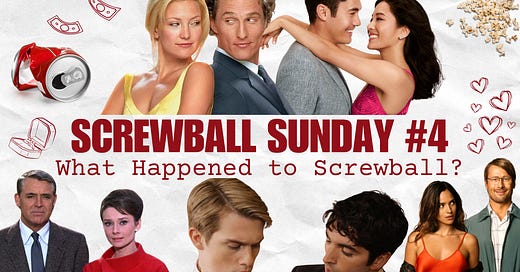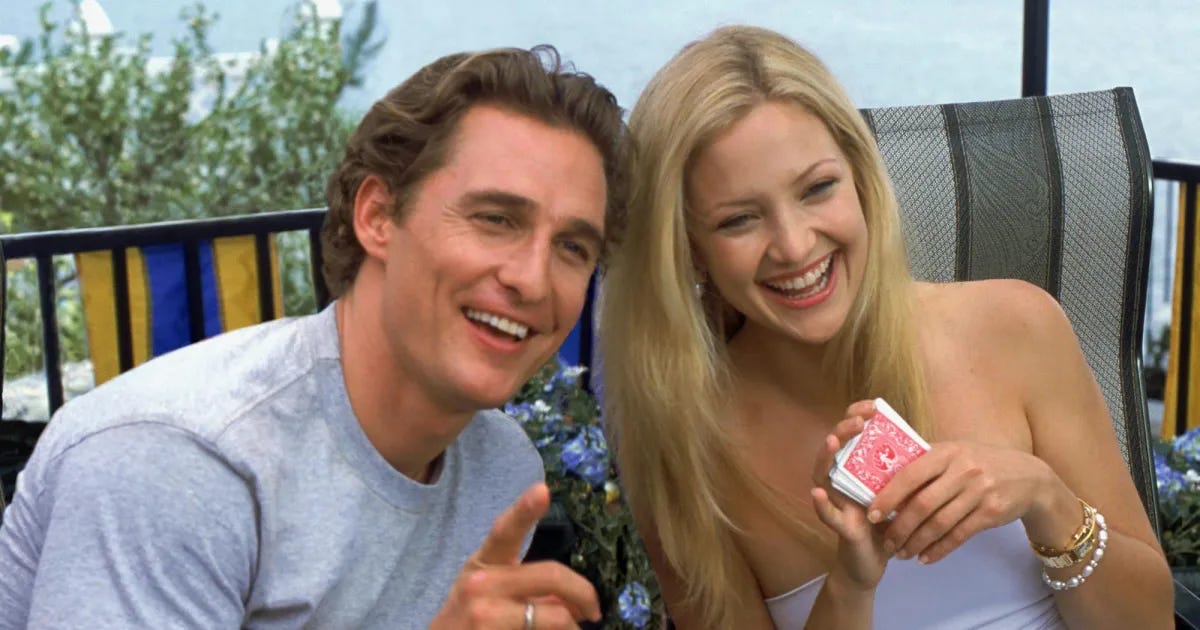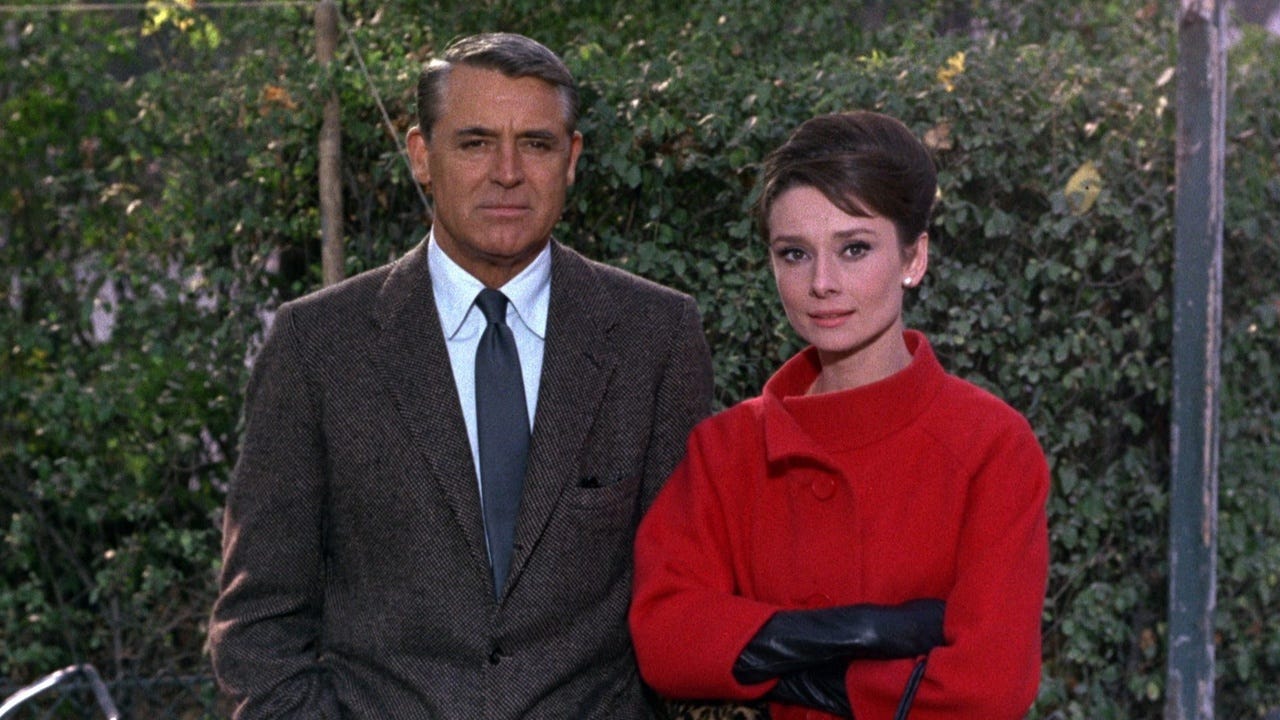Catch up on the previous instalments of the Screwball Sunday series.
And make sure you are subscribed to get future ones directly into your inbox!
In the previous weeks, we discussed how screwball comedy came to be and how the genre ultimately disappeared with the arrival of World War II. This is not surprising given that a lot of the defining traits of the genre came as a result of socioeconomic circumstances of the early 1930s. However, despite being very specific, the genre’s combination of traits allowed for individual traits to persist and continue to be used in film in years to come. Nowadays, films across genres utilise some of screwball’s defining traits, allowing the genre to live on.
While there are a number of films in the early decades following the 1940s demise of screwball that can illustrate how its traits persisted, I am going to start with what is perhaps the modern film that came the closest to replicating screwball comedy – How to Lose a Guy in 10 Days (2003).
The plot of the film is pretty straight forward. Andy, a magazine writer, meets Benjamin, a marketing executive, while writing a column on how to lose a guy in 10 days. While she dates him with the purpose of losing him, Benjamin makes a bet with his colleagues that he can make any woman fall in love with him in 10 days. Without diving beyond the surface, the film already has some clear screwball traits – a strong female character and a perfect setup for the so-called battle of the sexes. Many early 2000s romcoms centre around female journalists, something we’ve seen in screwball comedies such as His Girl Friday (1940) or Woman of the Year (1942). In their intent to achieve their goals, Andy and Benji bicker and banter, allowing for dynamic dialogue and sexual tension to seep through, touching additional screwball cornerstones. The story is no longer under the constraints of the Hays Code and shifts in society allow for the omission of certain screwball archetypes (e.g. the spoiled heiress) that worked well in 1930s, but for all purposes, How to Lose a Guy in 10 Days is the perfect modern screwball. It replicates the dynamic between leads that emerged during the screwball era and sticks to a plot narrative that would have worked in the late 1930s just as well as it worked in 2003 and continues to work today.
A number of other modern romcoms also look at screwball when it comes to setting a dynamic between the romantic leads. One of my personal favourites is last year’s Amazon hit Red, White & Royal Blue. It’s a queer love story leveraging the sexual tension between the leads in a way Hays Code certainly wouldn’t have allowed but it still uses the same techniques of banter and dynamic dialogue that we’ve seen in screwball. It doesn’t feature a spoiled heiress but there is a prince and his American love interest who may not be working class but represents the commoner in this particular dynamic. The film’s director, Matthew Lopez, even shared in an interview that the dynamic between the leads was inspired by the dynamic between Katharine Hepburn and Cary Grant’s characters in Bringing Up Baby (1938).1 While How to Lose a Guy in 10 Days may tick more boxes on the list of screwball traits it uses, I find Red, White & Royal Blue to be a great example of how modern romantic comedy has managed to take key screwball principles and apply them to stories and characters that have been kept out of the genre during the screwball era. While screwball did make references to homosexuality – for example, the famous His Girl Friday (1940) scene where Rosalind Russell’s character describes her new fiancé to Cary Grant’s character to which he responds with “sounds like a guy I ought to marry” – it’s a genre that fully operated under the restrictions of the Hays Code. In fact, the genre was born as a result of the Hays Code, meaning that modern comedy now has the opportunity to explore certain topics that screwball never did while remaining under the screwball umbrella and borrowing some of its key elements to recreate the genre in a modern setting.
Speaking of underrepresented communities in screwball, one of my all-time favourite romcoms is Crazy Rich Asians (2018). This is not a film that I would classify as ‘modern screwball’ in the same way that I would the other two films I’ve just discussed; however, it centres around one key element of screwball that both How to Lose a Guy in 10 Days and Red, White & Royal Blue don’t – economic disparity. It does so in a slightly different way than screwball does with the male lead being the wealthy one while keeping the female character a representative of the working class. Rachel, our main character, is portrayed as intelligent and independent, a young economics professor at NYU, which aligns with how screwball portrayed its female leads who weren’t spoiled heiresses – think His Girl Friday’s Hildy. The film critiques the upper class and their insensitivity to the issues of working class people in a similar manner that screwball does and ultimately allows its leads to get their happily ever after despite the economic differences between them, while softening the upper class characters and portraying what can be seen as a ‘win’ for our working class female lead.
A very recent example of a film critiquing the upper class is this year’s Palme d’Or winner Anora. In my recent review of Anora, I discussed how it uses elements of screwball and flips classic tropes on their head to add modern elements to the film. Anora is again a film that would have never gotten past the Hays Code but in a time in history when economic disparity is probably as large as it was in the early 30s and there is certainly a sentiment of general dislike for the wastefulness of billionaires and the price people and the planet are paying for their lifestyles, Anora’s revival of the ‘battle of the social classes’ screwball trait seems timely and appropriate, just as the birth of this trait was timely in the aftermath of the Great Depression.
One of Anora’s traits that I personally find appealing – and one that very well may be the reason the film works so well – is its refusal to stick to a specific genre. But, it certainly isn’t the film that invented that way of telling a story. My all-time favourite film Charade (1963) does just the same. I am not claiming it was the first film to do so, but I believe it serves as a great example of a genre-bending film from an era much closer to the end of screwball than the likes of Anora. Charade, starring Audrey Hepburn and Cary Grant, is a film that some call ‘the most Hitchcock film not directed by Hitchcock.’ I’m inclined to agree with the statement. It’s a great mystery, a thriller with elements of comedy and romance. It features a third act chase, lots of innuendos, a rich, out of touch, female lead, and a clever back and forth between Audrey Hepburn and Cary Grant that gives it a feel of a perfect screwball comedy. In a lot of ways, I like to think of this film as the answer to the question ‘what if screwball comedy featured murder?’ Hit Man (2023) is a great modern example of a similar film, featuring crime and romance, and looking back to my review of the film now, there are quite a few similarities between Glen Powell’s performance in it and Cary Grant’s recognizable style. While neither Hit Man nor Charade replicate screwball in the way romantic comedies like How to Lose a Guy in 10 Days might, both films are heavily reliant on elements of the screwball genre and wouldn’t work without them. At least not in the way we know them now.
While screwball comedy disappeared in the early 1940s, it is a genre that undoubtedly left a mark on the film industry and storytelling as a whole. Looking at modern favourites, many leverage elements of storytelling developed during the screwball era and many likely wouldn’t be as good and beloved as they are without those elements. Fiction often reflects our reality and our reality helps mould genres as has been the case with screwball. Similarly, as they become (or remain) relevant again, elements of extinct genres will make their way back into fiction. After all, effective storytelling will prevail even as the contexts in which it evolved becomes outdated.
Discussion Questions
Can you think of other modern films that heavily use screwball elements?
This post mentions how Anora seamlessly switches genres. Think of other films that don’t fit a particular genre. Why do they work?
While screwball comedy no longer exists, one could argue it evolved into modern romantic comedy to keep up with the times. Pick another genre and think about how it’s evolved over the course of the past 100 years of cinema.
Recommended Viewing
Charade (1963)
How to Lose a Guy in 10 Days (2003)
Crazy Rich Asians (2018)
Red, White & Royal Blue (2023)
Anora (2024)





![[Screwball Sunday #1] Defining the Genre](https://substackcdn.com/image/fetch/$s_!E_bk!,w_140,h_140,c_fill,f_auto,q_auto:good,fl_progressive:steep,g_auto/https%3A%2F%2Fsubstack-post-media.s3.amazonaws.com%2Fpublic%2Fimages%2F3dabf135-1a31-4862-802d-d7cfa0ed8d04_1456x1048.png)
![[Screwball Sunday #2] Shaping Screwball](https://substackcdn.com/image/fetch/$s_!qCR2!,w_140,h_140,c_fill,f_auto,q_auto:good,fl_progressive:steep,g_auto/https%3A%2F%2Fsubstack-post-media.s3.amazonaws.com%2Fpublic%2Fimages%2Fa8456d89-6724-46f5-8062-cbae898bbead_1456x1048.png)
![[Screwball Sunday #3] My Man Godfrey](https://substackcdn.com/image/fetch/$s_!1iA2!,w_140,h_140,c_fill,f_auto,q_auto:good,fl_progressive:steep,g_auto/https%3A%2F%2Fsubstack-post-media.s3.amazonaws.com%2Fpublic%2Fimages%2F8e227289-f557-434c-8b09-0a46e136629c_1456x1048.png)




It seems fitting that Charade would have elements of screwball mixed into its other genres, since it's also been called one of the last 'golden age' movies - might as well meld together all of the genres that contributed to the era.
I've enjoyed reading through your screwball series! The mix of class and tomfoolery in those movies...I'm glad they've been preserved for the screen.